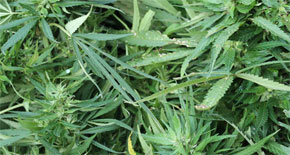Florida Rolls Out Plan For High Stakes Pot Farming Industry
July 6, 2014
Winners of Florida’s five, highly sought-after medical marijuana licenses could be selected through lotteries, according to a draft rule released last week by the Department of Health.
The 16-page document comes in advance of an agency workshop Monday in Tallahassee that is drawing heavy attention.
 The draft rule, generally considered a starting point, outlines how the state intends to implement a new law, signed by Gov. Scott, that made Florida one of nearly two dozen states that permit some sort of marijuana. Florida’s law restricts legal marijuana to strains that are low in euphoria-inducing tetrahydrocannabinol, or THC, and high in cannabadiol, or CBD. The low-THC, high-CBD strain is purported to eliminate or dramatically reduce life-threatening seizures in children with severe epilepsy. The law also allows patients who suffer from severe muscle spasms or cancer to be put on a “compassionate use registry” for the low-THC product as long as their doctors approve.
The draft rule, generally considered a starting point, outlines how the state intends to implement a new law, signed by Gov. Scott, that made Florida one of nearly two dozen states that permit some sort of marijuana. Florida’s law restricts legal marijuana to strains that are low in euphoria-inducing tetrahydrocannabinol, or THC, and high in cannabadiol, or CBD. The low-THC, high-CBD strain is purported to eliminate or dramatically reduce life-threatening seizures in children with severe epilepsy. The law also allows patients who suffer from severe muscle spasms or cancer to be put on a “compassionate use registry” for the low-THC product as long as their doctors approve.
The Florida law also requires that cultivation, processing and distribution of the final product take place at the same locations and allows for one dispensary in each of five different regions of the state. Growers are limited to nurseries that have been doing business in Florida for at least 30 years and are producing at least 400,000 plants. Currently, 41 nurseries meet that criteria, according to the Florida Department of Agriculture and Consumer Services.
If there is more than one applicant within a region, “a public lottery will be held to determine the order in which applications are considered,” according to the draft rule. The first complete application that meets all of the eligibility requirements would be the winner.
The chosen dispensary would have 30 days to pay $150,000 for a license and post a $5 million performance bond. If the applicant fails to meet the financial obligations, the department would start the selection process over again.
Applicants would have 10 days to apply once the rule goes into effect, a short window of time for those trying to break into the state’s newest regulated industry.
Under the rule, dispensaries would have to be open a minimum of 30 hours per week and operate between 7 a.m. and 10 p.m. And the rule would also bar sales of any edible products like cookies or candy.
Applicants would also have to provide documentation that they have the ability to obtain the premises, resources and personnel necessary to operate as a dispensing organization, including maps showing the location of facilities; site plans drawn to scale of the cultivation, processing and dispensing areas; and photographs showing the parking lot and entryways into the building.
Also, applicants would be required to include a list of staff members, who must all be over the age of 21, and prove that they have passed background screenings. The application must also include proof that individuals who are owners have passed background screenings.
According to the proposed rule, the department could refuse to renew a license if a dispensary is within 500 feet of a school that existed before the organization submitted its initial application.
Applications could also be revoked if a dispensing organization does not begin cultivation within 60 days of approval or does not begin dispensing within 120 days. The products would have to be tested to verify the THC-CBD content and for the presence of chemical additives.
Any sample that has more than .8 percent THC or less than 10 percent CBD would have to be reported immediately to law enforcement officials, according to the rule. The entire batch would have to be destroyed.
The rule also includes protocols for inventory of the pot. Dispensaries would have to document each day’s beginning inventory, seeds and cuttings, harvest, processed products, sales, disbursements, disposal of unusable plants or products and ending inventory. Growers would also have to keep track of the cannabis harvests, including the harvest number; whether the harvest originated from seeds or cuttings; the origin and strain of seeds or cuttings; the number of seeds or cuttings; the date the seeds or cuttings were planted; lists of all chemical additives; the number of plants grown to maturity; the date of harvest; final harvest yield weight; disposal of plants or plant parts not used for production; and the reason and methods of disposal, including the name of the agent responsible for the disposal.
All of the cultivation, processing, storage and dispensing and “any other activity involving low-THC cannabis” must take place “in an enclosed and locked facility,” according to the draft rule.
by Dara Kim, The News Service of Florida
Comments
3 Responses to “Florida Rolls Out Plan For High Stakes Pot Farming Industry”



Where is the equal opportunity for the smaller scale nurseries?
This thing is rigged from the ground up with protectionism and favoritism built right in.
$150.000 license fee and a $5 million performance bond, 400,000 plants. I would have a license lottery and lower these fees to allow smaller nurseries to compete in a free market.
I thought we lived in a free market. Where’s the smaller government?
Lottery huh? Sounds like the “fix” is in. Follow the money-and the political connections